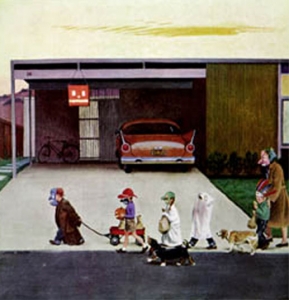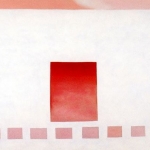
John P. Falter (1910-1982)|Trick-Or-Treating in the Burbs58|Cover illustration for The Saturday Evening Post (November 1, 1958)|© 1958 SEPS: Licensed by Curtis Publishing, Indianapolis, IN
The 1950s is when American familial goals transformed from home and apple pie to a home in the suburbs, two cars in the garage, and living the good life. John P. Falter’s illustration for the 1958 Halloween cover of The Saturday Evening Post delineates a look of that good life. In the foreground five children, two dogs and a Mom walk the sidewalk and streets of a new suburban residential community with its ranch-style houses and lack of street curbs. The grass, street, and driveway are all pristine since there are no grand old trees visible to shed their fall foliage. The carport holds one new 1958 car with its blade-like fins. While one of the trick-or-treaters carries a lit pumpkin (dangerous to be sure), there is no carved pumpkin in front of the house; instead a constructed paper pumpkin(perhaps lantern) face hangs from the carport eaves. The exaggerated fins and exhaust jets protruding from the car’s rear bumper are reminiscent of the Plymouth Belvedere detailing of 1958. I cannot identify the make of the car, but like the bit of the house we can see in this illustration, it speaks of cutting edge modernity situated in an American suburb. Surprisingly this illustration weirdly echoes Georgia O’Keeffe’s 1960 painting of her Abiquiu, New Mexico house, White Patio With Red Door. O’Keeffe’s tile stepping stones march across her painting as the square flagstones at the far left of Falter’s illustration recede on their way to the side of the rectilinear house. Even modernity is based upon an older past. 
The troupe of revelers tramp the street as dusk descends and the wisp of clouds in the twilight sky turn yellow in the lowering light. By placing the figures in the foreground as a frieze, Falter indicates that they are making their neighborhood circuit. All but one of the humans are masked even though their costumed disguises are minimal: a Dad’s over-sized sport jacket, a sheet or pillowcase serving another duty, and a child’s Indian war bonnet. Only the adult with her hair covered with a scarf and the boy with the ghost pillowcase are fully disguised. Perhaps this tableau inspired Steven Spielberg’s Halloween celebrants in the 1982 movie, E.T. The scary masks with their exaggerated features and malevolent teeth echo the aggressive aspect of sedan’s blade-sharp fins and wide red-eyed tail lights. The implied line of revelers breaks forward and backward in the shallow foreground space of the scene with the accompanying basset hound not only furthest forward in the picture plane but also providing the unheard sound effect with his visible howl. For such a benign scene an aura of creepiness reigns.
Because this frieze of figures are viewed from the side we see the masked and un-masked parts of their faces, two-faced as it were, but not necessarily Janus-headed. Nevertheless, the notion of the Roman god Janus marking the beginnings and ending of things is remarkable apt. In areas of America where the changing seasons are more marked, Halloween denotes the end of fall and heralds the beginning of winter. Although here in 1950s American western suburbia, only perpetual summer seems to rule.
Happy Halloween
October 29, 2009
By Joyce K. Schiller, Curator, Rockwell Center for American Visual Studies
Norman Rockwell Museum






